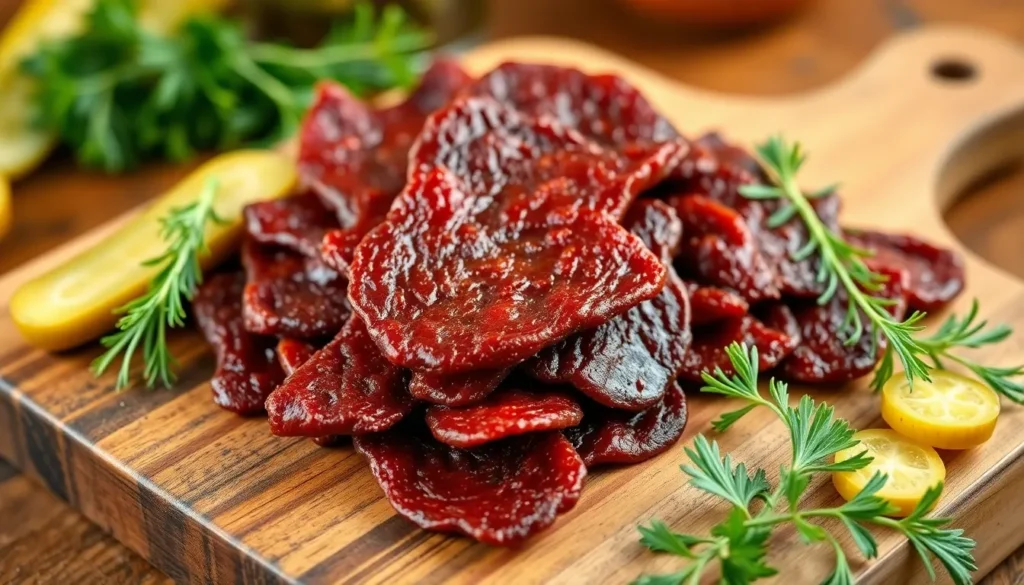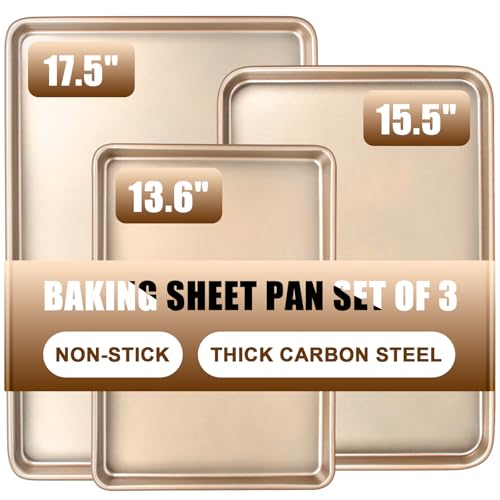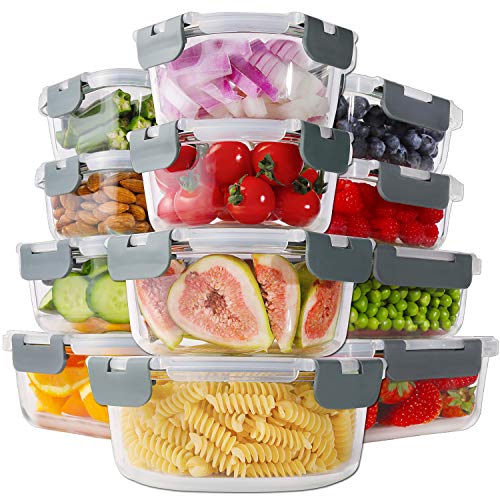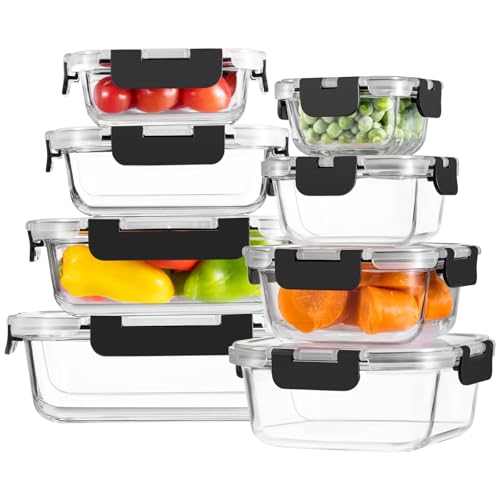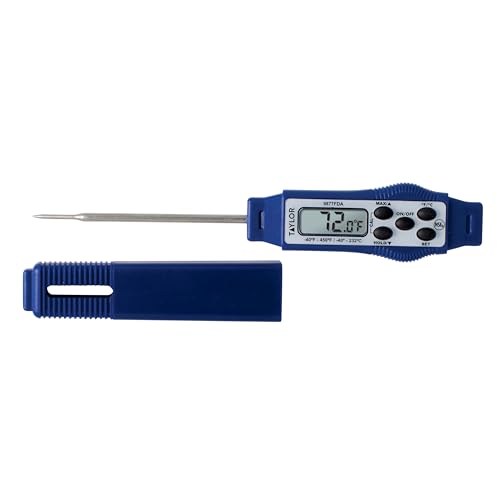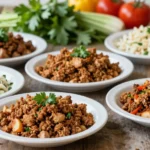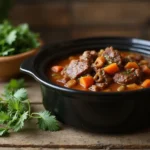Nothing beats the tangy crunch of a good dill pickle – except maybe turning that iconic flavor into tender, chewy beef jerky that’s perfect for any adventure. We’ve cracked the code on combining two beloved snacks into one irresistible treat that’ll have your taste buds doing a happy dance.
Our dill pickle beef jerky recipe transforms ordinary lean beef into a protein-packed powerhouse that captures all the zesty, garlicky goodness you crave. The secret lies in our carefully crafted marinade that infuses every fiber with that distinctive pickle brine flavor we all know and love.
Whether you’re planning a hiking trip, need a satisfying office snack, or want to impress friends at your next gathering, this homemade jerky delivers maximum flavor with minimal effort. We’ll walk you through each step to create jerky that’s far superior to anything you’ll find in stores – and at a fraction of the cost.
Ingredients
We’ve carefully selected high-quality ingredients that deliver the perfect balance of tangy pickle flavor and savory beef taste. Our ingredient list ensures you create restaurant-quality dill pickle beef jerky right in your own kitchen.
For the Beef
- 2 pounds eye of round roast or top round roast, trimmed of visible fat
- 1 pound flank steak (optional, for varied texture)
For the Dill Pickle Marinade
- 1 cup dill pickle juice (from a jar of dill pickles)
- 1/4 cup apple cider vinegar
- 2 tablespoons Worcestershire sauce
- 2 tablespoons soy sauce
- 1 tablespoon liquid smoke
- 2 teaspoons garlic powder
- 1 teaspoon onion powder
- 1/2 teaspoon black pepper
- 1/4 cup finely chopped fresh dill
- 2 tablespoons brown sugar
For the Seasoning Blend
- 2 teaspoons dried dill weed
- 1 teaspoon garlic powder
- 1 teaspoon onion powder
- 1/2 teaspoon mustard seed powder
- 1/2 teaspoon coriander seeds, ground
- 1/4 teaspoon white pepper
- 1/4 teaspoon celery seed
- 1/8 teaspoon cayenne pepper (optional, for heat)
Equipment Needed
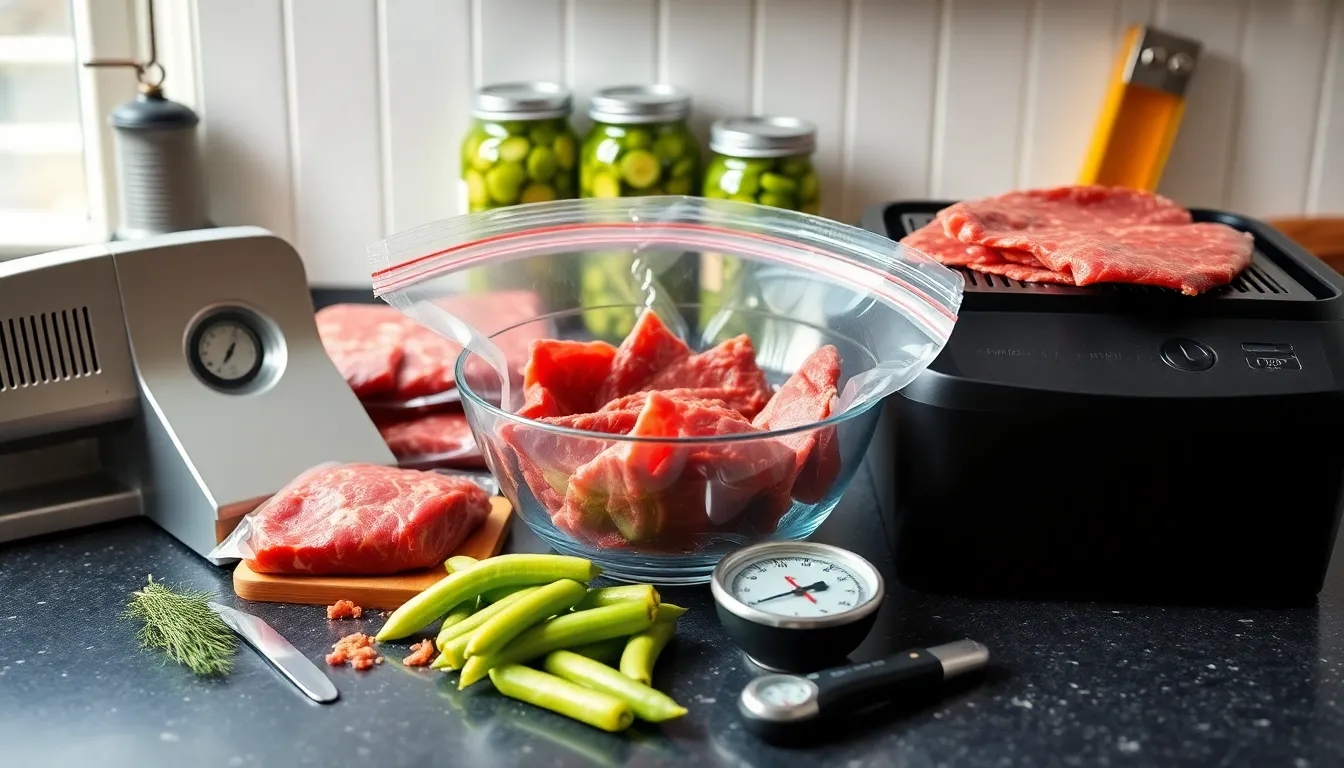
Creating perfect dill pickle beef jerky requires the right tools to ensure consistent results and food safety. We’ve compiled this essential equipment list to help you achieve professional quality jerky from your home kitchen.
Meat Slicer or Sharp Knife stands as our most critical tool for this recipe. We need to slice our beef into uniform ¼ inch thick strips to ensure even drying. A sharp knife works perfectly for smaller batches while a meat slicer delivers consistent thickness for larger quantities.
Meat Tenderizer helps us achieve better marinade absorption and consistent texture throughout each piece. We use this tool to even out the thickness of our beef strips and break down tough fibers for more tender jerky.
Large Mixing Bowl becomes essential for combining our marinade ingredients thoroughly. We recommend using a non-reactive bowl made of glass or stainless steel to prevent any interaction with the acidic pickle juice.
Sealable Container or Zip-Top Bag allows us to marinate our beef properly in the refrigerator. We prefer using gallon-sized zip-top bags as they provide excellent contact between the meat and marinade while saving refrigerator space.
Dehydrator represents our preferred drying method for consistent temperature control and even air circulation. We recommend setting the temperature between 140-160°F for optimal results. An oven can serve as an alternative though it requires more careful monitoring.
Dehydrator Trays or Mesh-Lined Trays ensure proper air circulation around each piece of meat. We arrange our marinated beef strips in single layers without overlapping to achieve uniform drying.
Thermometer helps us monitor our drying temperature accurately whether using a dehydrator or oven method. We maintain temperatures between 140-160°F throughout the 4-6 hour drying process for food safety and quality.
| Equipment | Purpose | Temperature Range |
|---|---|---|
| Dehydrator | Primary drying method | 140-160°F |
| Thermometer | Temperature monitoring | 140-160°F |
| Meat Slicer/Knife | Uniform slicing | N/A |
| Drying Time | Complete dehydration | 4-6 hours |
Having these tools ready before we start ensures smooth preparation and professional results that rival any store-bought jerky.
Instructions
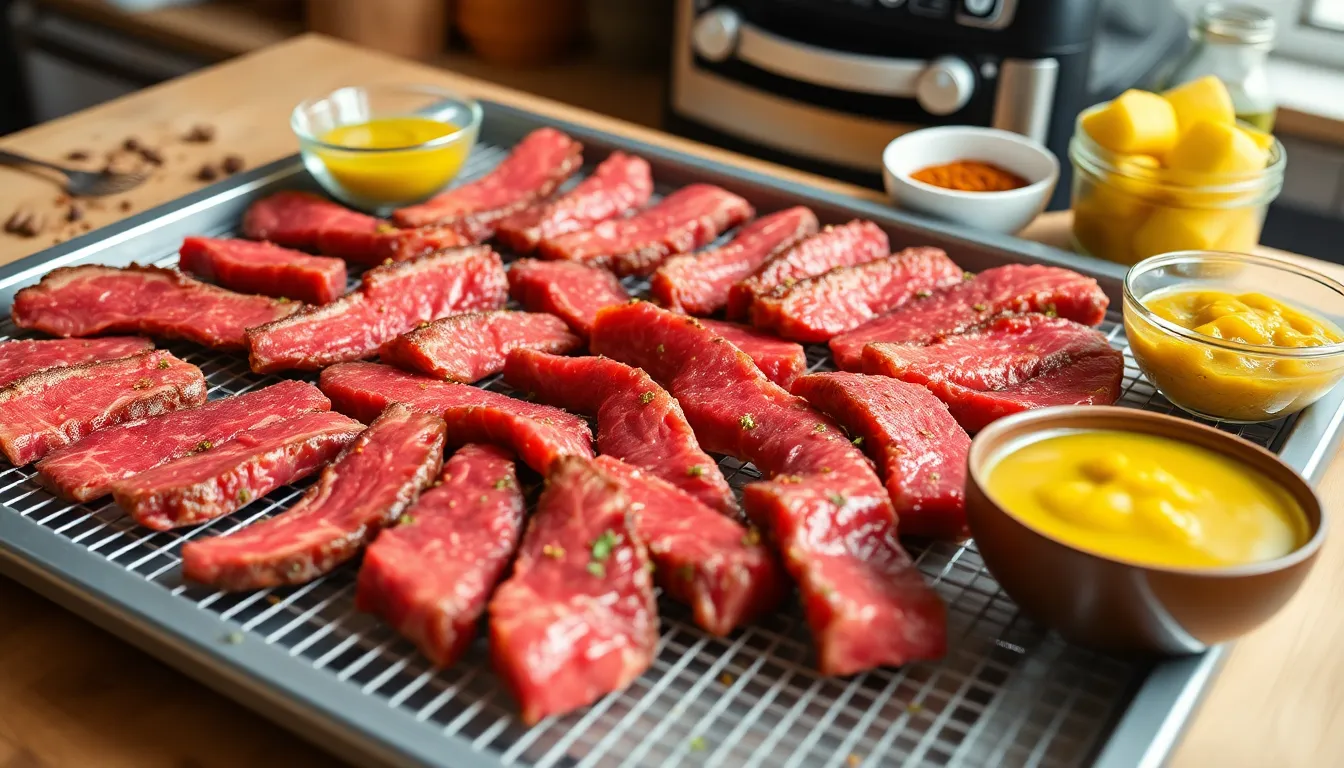
Now we transform our carefully selected ingredients into irresistible dill pickle beef jerky. Follow these detailed steps to achieve professional results every time.
Prep the Beef
Start with 1 pound of lean beef such as top round or sirloin for optimal results. Slice the beef into ¼-inch thick strips with lengths measuring 1 to 2 inches wide for consistent drying. We recommend cutting against the grain to ensure tender jerky that’s easy to chew.
Lightly tenderize each strip using our meat tenderizer to create uniform thickness throughout. This step ensures better marinade absorption and prevents uneven drying during the dehydration process.
Prepare the Marinade
Combine ¼ cup pickle juice from dill pickles with ¼ cup prepared yellow mustard in our large mixing bowl. Add 2 tablespoons hot sauce for heat lovers or skip this ingredient for milder flavor profiles.
Mix in 2 teaspoons dried dill to enhance the pickle essence throughout each bite. Incorporate 1 teaspoon garlic powder and 1 teaspoon onion powder for savory depth. Season with salt and black pepper according to your taste preferences.
Add 2 pinches cayenne pepper for those who enjoy extra spice in their jerky. Whisk all ingredients together until the marinade reaches a smooth consistency.
Marinate the Beef
Place the beef strips into our sealable container and pour the prepared marinade over them completely. Stir and fold the beef gently to ensure every piece receives thorough coating with our flavorful mixture.
Cover the container tightly and refrigerate for 12 to 24 hours minimum. During this time the beef absorbs the marinade and becomes noticeably thicker as flavors penetrate deep into the meat fibers.
Set Up the Dehydrator
Arrange the marinated beef strips on dehydrator trays lined with mesh or parchment paper for easy removal. Leave adequate space between each piece to allow proper air circulation during the drying process.
We ensure no pieces overlap or touch each other as this prevents even dehydration and can create inconsistent textures in our finished jerky.
Dehydrate the Jerky
Set our dehydrator temperature to 160°F using the built-in thermometer for accurate monitoring. Begin the dehydration process which typically requires approximately 6 hours for complete drying.
Check the jerky progress after 4 to 5 hours since dehydrator models and strip thickness can affect total drying time. We adjust timing based on our exact equipment and desired texture preferences.
Check for Doneness
Test the jerky by bending a piece gently between your fingers. Properly finished jerky feels dry but remains pliable without breaking or cracking under light pressure.
The surface should not feel sticky or overly leathery when touched. Continue dehydrating for additional time if the jerky still feels moist or doesn’t pass our bend test for optimal texture.
Dehydrator Method
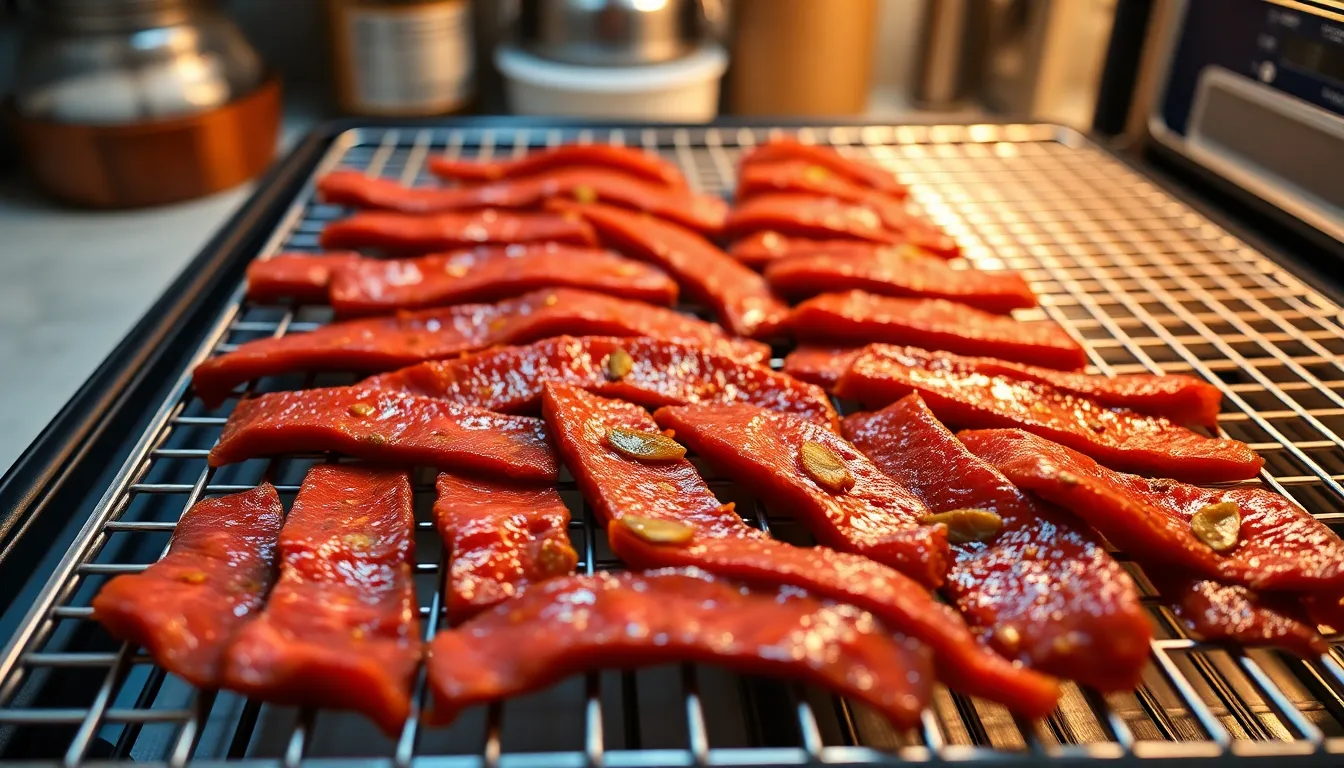
Now that our beef strips have absorbed all those tangy pickle flavors during the marinating process we can move on to the dehydration stage. Setting up our dehydrator correctly ensures we achieve that perfect chewy texture we’re looking for in our dill pickle beef jerky.
We start by removing each beef strip from the marinade and gently patting them dry with paper towels. This step prevents excess liquid from dripping onto the dehydrator trays during the drying process. Our beef strips should still retain that distinctive pickle aroma while feeling slightly tacky to the touch.
Temperature Settings
We set our dehydrator to 160°F for optimal results. This temperature strikes the perfect balance between removing moisture effectively and preserving the tender texture of our marinated beef. Lower temperatures extend drying time unnecessarily while higher temperatures risk creating tough or brittle jerky.
Arranging the Beef Strips
Proper spacing becomes crucial for even dehydration. We arrange our marinated beef strips on the dehydrator racks without any pieces overlapping or touching. Air circulation around each strip ensures uniform drying throughout the batch. Each strip should lie flat against the rack surface to prevent curling during the drying process.
Dehydration Timeline
Our dill pickle beef jerky requires approximately 6 to 8 hours of dehydration time. We check the progress every 2 hours after the initial 4-hour mark to monitor texture development. The jerky reaches completion when it feels firm to the touch but still maintains flexibility when bent.
Testing for Doneness
We test our jerky by selecting a piece from the center of a rack and bending it gently. Properly dried dill pickle beef jerky should bend without breaking or cracking. The surface should appear dry with no visible moisture beads. Our finished jerky will have a deep reddish-brown color with that characteristic pickle tang still present in its aroma.
Oven Method
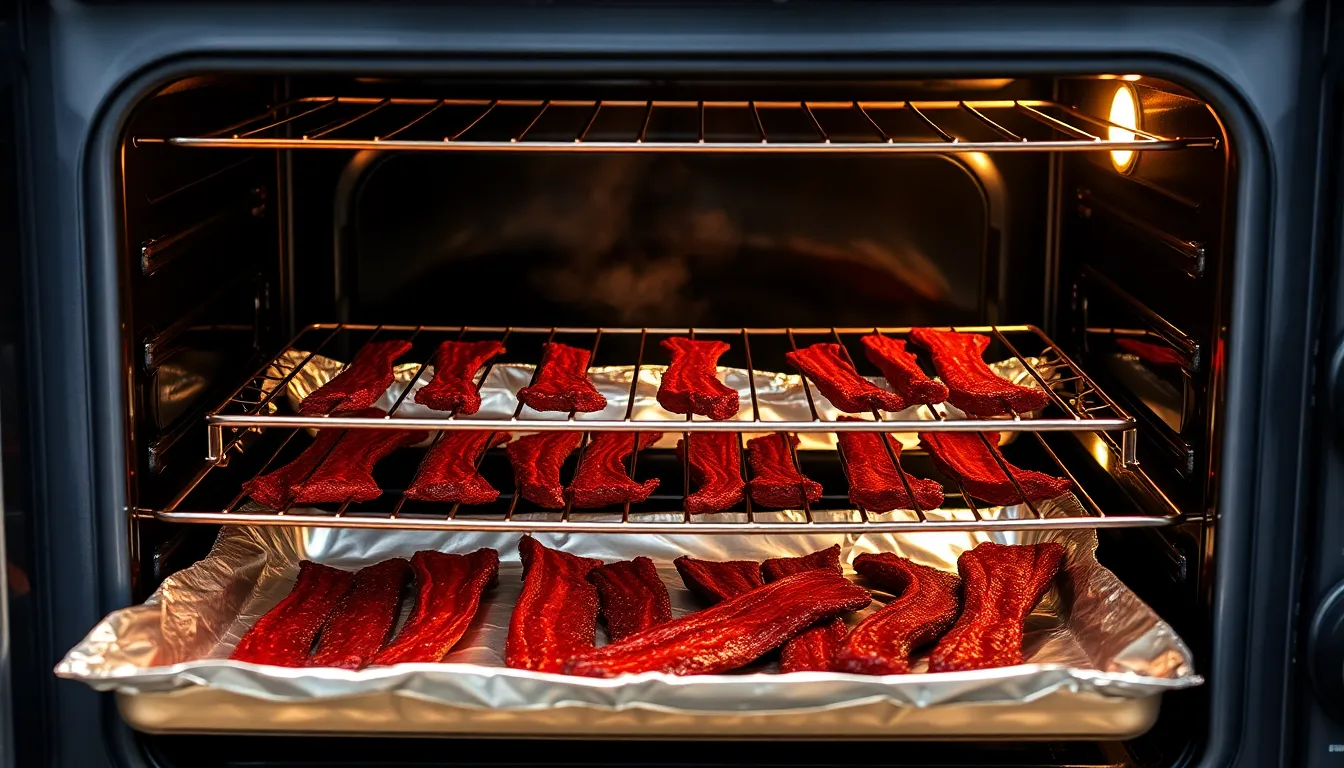
Creating dill pickle beef jerky in your oven provides an accessible alternative when a dehydrator isn’t available. This method delivers excellent results with proper temperature control and careful monitoring.
Temperature and Time Settings
We recommend setting your oven to 175°F for optimal jerky dehydration. Most home ovens can achieve this temperature setting perfectly for our dill pickle beef jerky recipe.
| Temperature Setting | Time Duration | Oven Type |
|---|---|---|
| 175°F | 6 hours | Standard oven |
| 170°F | 6-7 hours | Convection oven |
| Warm setting | 7-8 hours | Limited temperature ovens |
Position your oven racks in the center for even heat distribution throughout the drying process. We place the marinated beef strips on wire racks set over baking sheets lined with aluminum foil to catch any drippings. This setup ensures proper air circulation around each piece of jerky.
Convection ovens work exceptionally well for this recipe because they circulate air continuously around the beef strips. We reduce the drying time by approximately 30 minutes when using convection settings while maintaining the same temperature.
Monitoring the Process
We check our dill pickle beef jerky after the first 3 hours to assess moisture levels and drying progress. The beef strips should begin showing signs of surface drying without becoming brittle at this stage.
Every hour following the initial check allows us to evaluate the jerky’s texture and color development. Properly dried jerky maintains flexibility when bent without breaking completely in half.
We test doneness by removing one strip and allowing it to cool for several minutes before bending. The jerky should crack slightly when folded but not snap into pieces immediately.
The finished product displays a deep reddish-brown color while retaining the distinctive dill pickle aroma from our marinade. We continue drying until the jerky feels firm to the touch with no visible moisture on the surface.
Our oven door remains slightly ajar during the final hour to release excess moisture and achieve the perfect chewy texture. This technique prevents over-drying while ensuring food safety standards are met throughout the process.
Storage Instructions
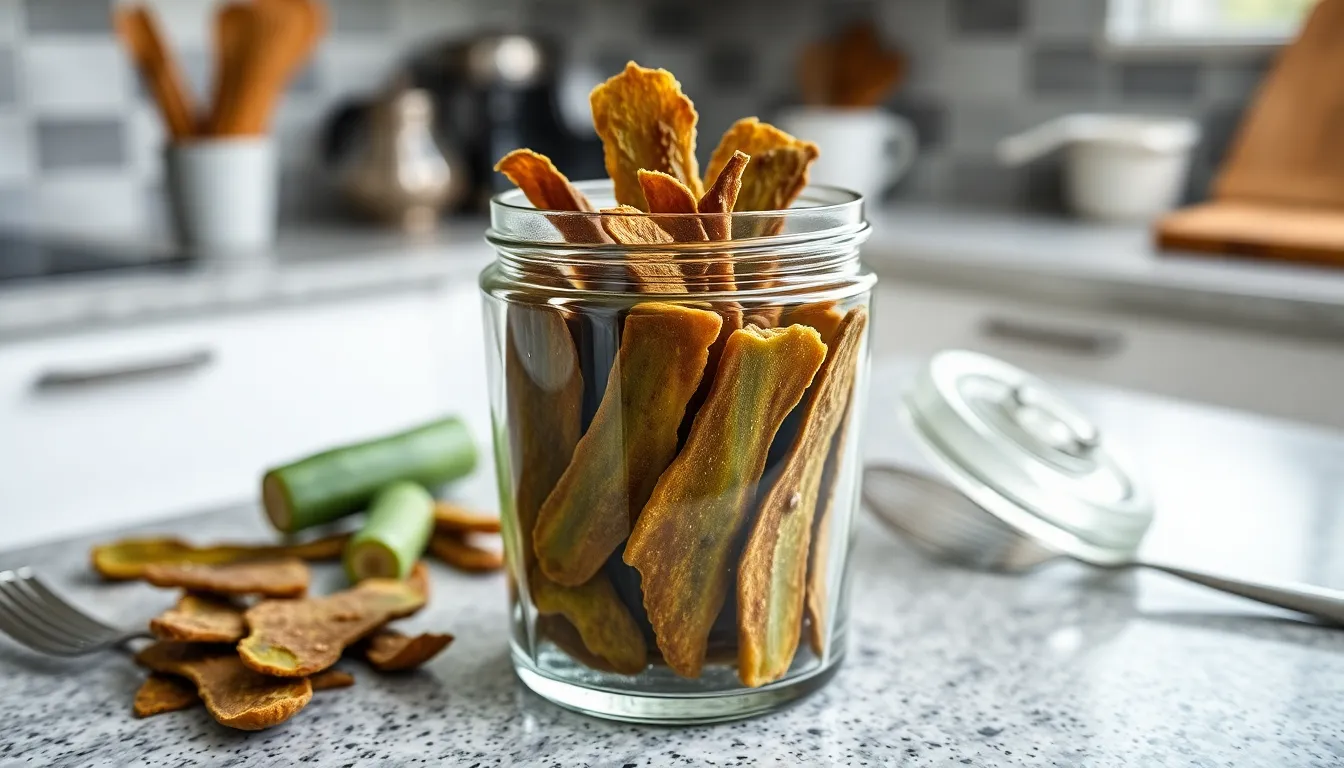
Proper storage preserves our dill pickle beef jerky’s tangy flavor and chewy texture while maintaining freshness. We’ll guide you through both short-term and long-term storage methods to maximize your jerky’s shelf life.
Short-Term Storage
Our freshly made dill pickle beef jerky stays at peak quality when stored in airtight containers at room temperature. We recommend transferring the completely cooled jerky into resealable plastic bags or glass containers with tight-fitting lids within 2 hours of finishing the dehydration process.
Store the containers in a cool, dry place away from direct sunlight and heat sources like stoves or radiators. Kitchen pantries and cupboards work perfectly for this purpose. The jerky maintains optimal flavor and texture for 1 to 2 weeks using this method.
We suggest checking the jerky every few days for any signs of moisture or mold. If you notice any white spots or off odors, discard the entire batch immediately to prevent foodborne illness.
Long-Term Storage
For extended freshness beyond two weeks, we store our dill pickle beef jerky in the refrigerator using airtight containers or vacuum-sealed bags. This method preserves the jerky’s quality for several months while maintaining its distinctive pickle flavor profile.
Vacuum sealing provides the best long-term storage results by removing excess air that can cause rancidity. We place vacuum-sealed packages in the freezer for maximum shelf life of up to 6 months without important quality loss.
| Storage Method | Duration | Temperature |
|---|---|---|
| Room Temperature | 1-2 weeks | Cool, dry place |
| Refrigerated | 3-6 months | 35-40°F |
| Frozen | 6 months | 0°F or below |
When thawing frozen jerky, we bring it to room temperature gradually to maintain the proper texture. Never microwave frozen jerky as this creates uneven heating and compromises the chewy consistency we worked hard to achieve.
Tips for Perfect Dill Pickle Beef Jerky
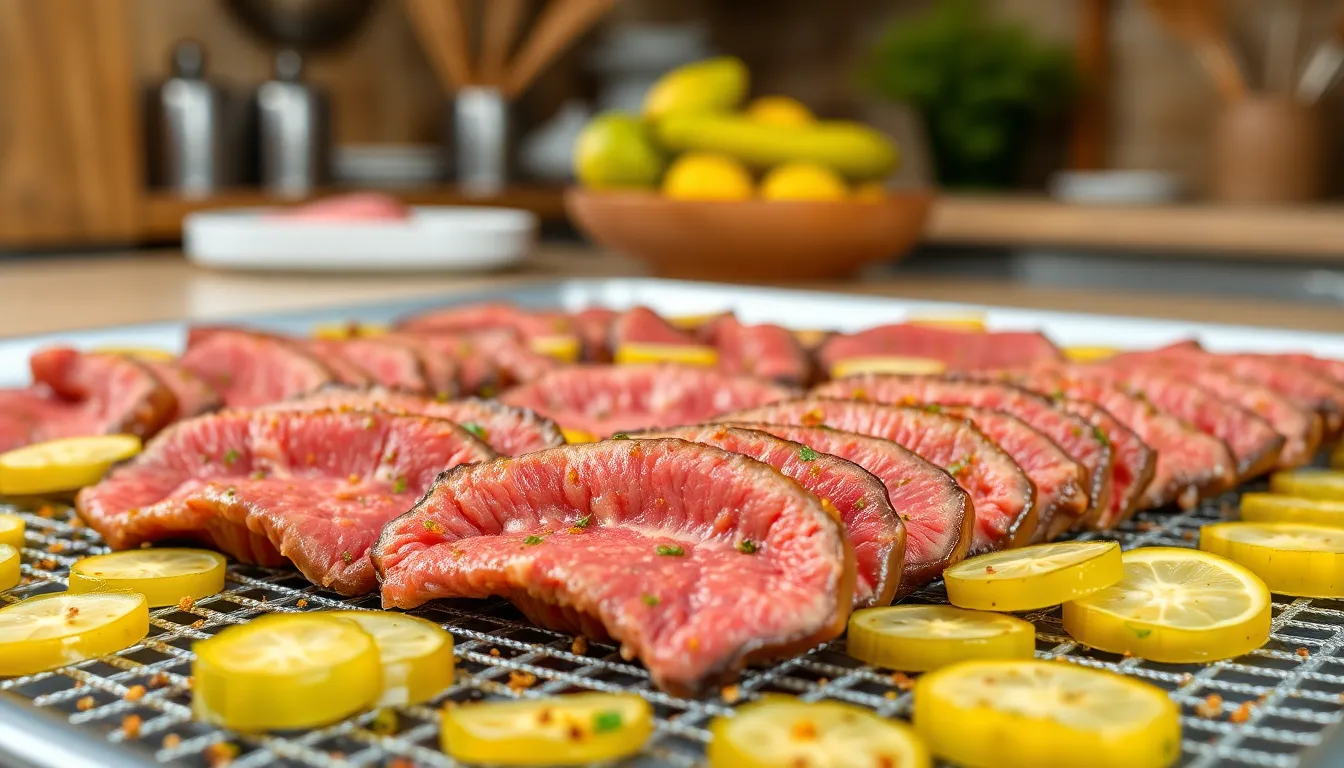
We’ve discovered that selecting the right cut of beef makes all the difference in achieving professional-quality dill pickle jerky. Eye of round, flank steak, and top round steak deliver the leanest texture with optimal drying characteristics. These cuts provide the perfect foundation for absorbing our tangy marinade while maintaining the ideal chewy consistency.
Slicing technique plays a crucial role in creating uniform jerky pieces. We recommend cutting beef strips to exactly 1/4 inch thickness to ensure consistent dehydration throughout the batch. Even thickness prevents some pieces from over-drying while others remain too moist.
Our marinating process requires patience for maximum flavor penetration. We always marinate the beef strips for a minimum of 12 hours in the dill pickle juice mixture. This extended time allows the tangy pickle flavors to fully infuse into the meat fibers.
Pickle juice serves as our secret weapon for authentic tanginess in every bite. We use either traditional dill pickle juice or bread and butter pickle juice as the marinade base. This approach delivers the genuine pickle flavor that sets our jerky apart from store-bought alternatives.
Spice combinations elevate the complexity of our dill pickle jerky beyond basic recipes. We incorporate dried mustard powder, Flavor God Honey BBQ seasoning, and crushed red pepper flakes to create layers of flavor. Garlic powder, onion powder, black pepper, mustard powder, and cayenne pepper add depth to the overall taste profile.
Temperature control during dehydration ensures optimal texture and safety. We maintain our dehydrator at precisely 160°F throughout the entire 6-hour drying process. This temperature eliminates harmful bacteria while preserving the jerky’s characteristic flexibility.
Proper spacing on dehydrator trays prevents uneven drying and potential spoilage. We arrange marinated meat strips without any overlapping to allow proper airflow around each piece. This technique guarantees consistent dehydration across our entire batch.
Texture testing helps us determine the perfect doneness for our dill pickle jerky. We look for meat that feels dry yet remains pliable when bent. Over-dried jerky becomes brittle and loses its appealing chewy consistency.
| Dehydration Factor | Specification |
|---|---|
| Temperature | 160°F |
| Duration | 6 hours |
| Beef Thickness | 1/4 inch |
| Marinating Time | 12 hours minimum |
Light tenderizing before marinating allows our pickle juice mixture to penetrate deeper into the meat fibers. We gently pound the beef strips to break down tough fibers without compromising the meat’s structure. This extra step results in more flavorful and tender finished jerky.
Variations and Flavor Modifications
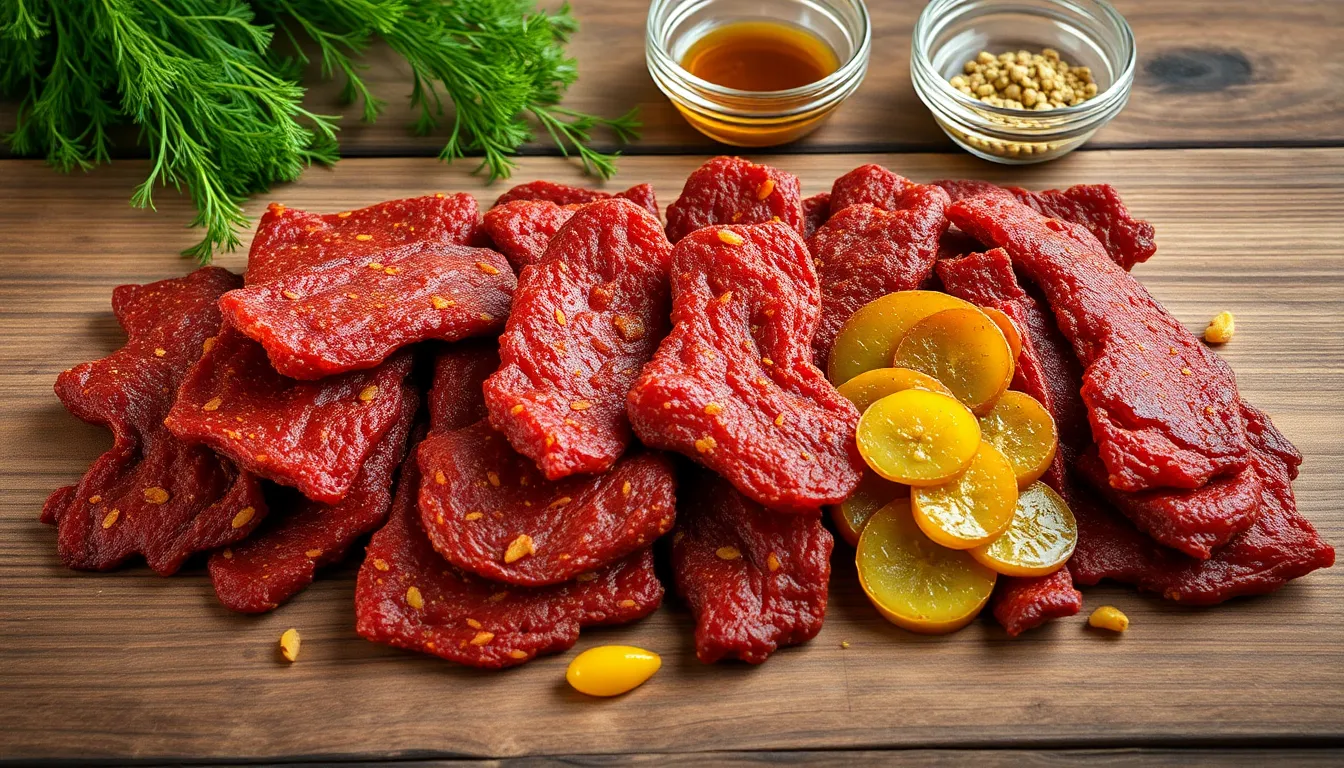
Our dill pickle beef jerky recipe transforms into multiple exciting variations that satisfy different taste preferences and dietary needs. We’ve tested many combinations to bring you the most successful flavor modifications that maintain the signature pickle taste while adding unique twists.
Spicy Dill Mustard Beef Jerky
We recommend this fiery variation for heat lovers who want to amplify the tangy pickle flavor. Our spicy version combines traditional dill pickle juice with yellow mustard and cayenne-based hot sauce like Frank’s RedHot. The marinade includes 1/4 cup dill pickle juice, 1/4 cup yellow mustard, 2 tablespoons hot sauce, 2 teaspoons dried dill, and cayenne pepper to taste. This combination creates a bold flavor profile that balances heat with the characteristic pickle tang.
Bread and Butter Pickle Beef Jerky
Sweet pickle enthusiasts will appreciate this variation that uses bread and butter pickle juice instead of traditional dill pickle brine. We enhance this sweeter base with Worcestershire sauce, garlic powder, onion powder, black pepper, salt, and liquid smoke. The result delivers a perfect balance between sweetness and smokiness that creates a more mellow jerky experience without losing the pickle essence.
Sweet Pickle Beef Jerky
Our sweet pickle variation takes the bread and butter concept further by incorporating honey and Dijon mustard into the marinade. We use sweet pickle juice as the foundation and add 2 tablespoons of honey plus 1 tablespoon of Dijon mustard for depth and complexity. This modification produces jerky with noticeable sweetness that complements the pickle flavor beautifully.
Flavor Enhancement Techniques
| Modification Type | Key Ingredients | Flavor Profile | Marinating Time |
|---|---|---|---|
| Spicy Dill Mustard | Pickle juice, yellow mustard, hot sauce, dried dill | Tangy and spicy | 12-24 hours |
| Bread and Butter | Sweet pickle juice, Worcestershire, liquid smoke | Sweet and smoky | 12-24 hours |
| Sweet Pickle | Sweet pickle juice, honey, Dijon mustard | Sweet and complex | 12-24 hours |
We suggest experimenting with different pickle juice types as your base since leftover juice from store-bought pickles works perfectly for these variations. Kosher dill, garlic dill, and spicy dill pickle juices each contribute distinct flavor notes to the final product. The acidity in pickle juice naturally tenderizes the beef while infusing it with flavor during the extended marinating period.
Adding liquid smoke to any variation introduces complexity that mimics traditional smokehouse jerky. We recommend starting with 1/2 teaspoon per pound of beef and adjusting according to your preference. Fresh or dried herbs like dill weed, garlic powder, and onion powder intensify the pickle flavor profile significantly.
Temperature control remains crucial regardless of which variation you choose. We maintain 160°F throughout the dehydration process for all variations to ensure food safety while achieving the proper texture. Each variation requires the same 6 to 8 hour dehydration time, though sweet variations may need slightly longer due to their higher sugar content.
Heat level customization allows you to create jerky that matches your spice tolerance perfectly. We adjust cayenne pepper, hot sauce, or crushed red pepper flakes incrementally to achieve the desired heat without overwhelming the pickle flavor. Testing small batches helps determine your preferred spice level before committing to larger quantities.
Troubleshooting Common Issues
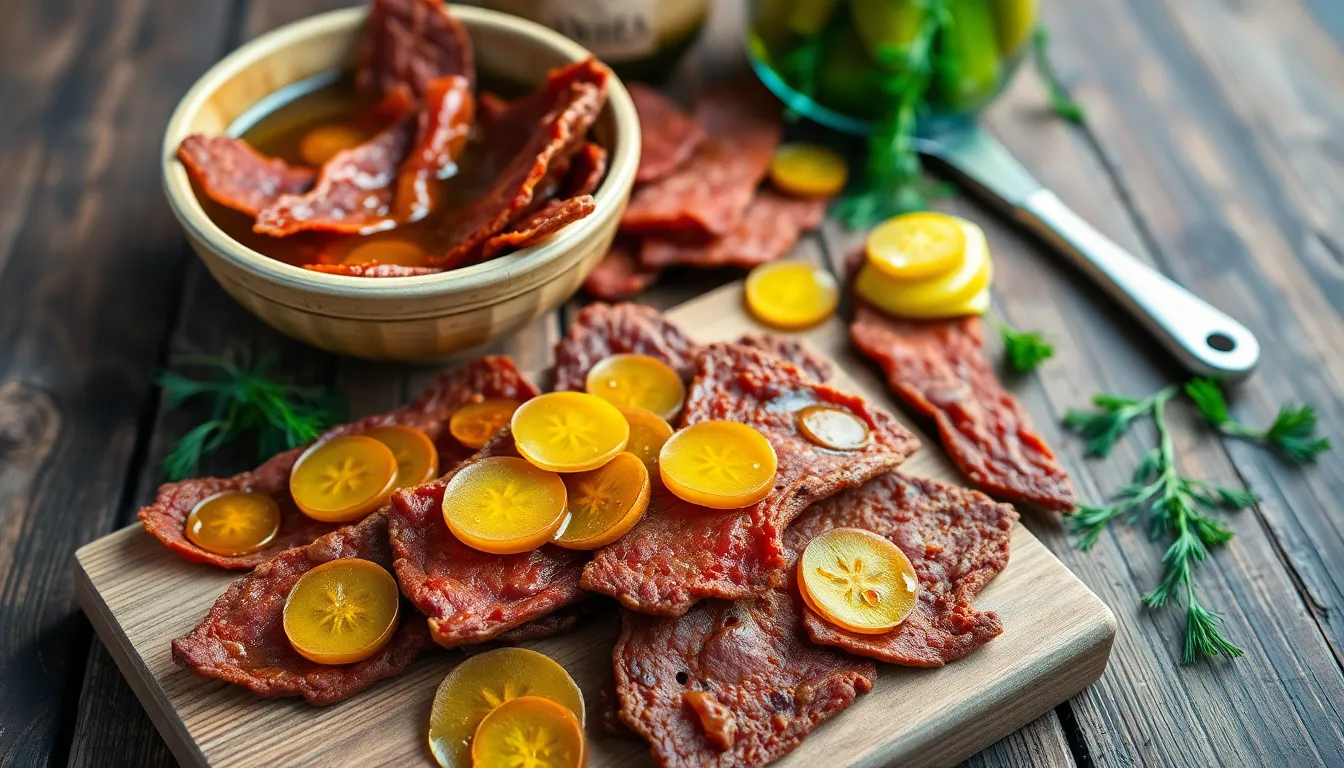
Even with careful preparation, we sometimes encounter challenges when making dill pickle beef jerky. Understanding these common issues helps us achieve perfect results every time.
Jerky Turns Out Too Dry or Brittle
Over-dehydration creates tough, brittle jerky that loses its appealing chewy texture. We monitor our jerky closely during the final hours of drying to prevent this common mistake. The ideal jerky should bend without breaking and maintain some flexibility when cooled. Remove strips from the dehydrator when they feel dry to the touch but still show slight pliability. Testing a piece every hour during the final stage prevents over-drying and ensures optimal texture.
Insufficient Pickle Flavor Penetration
Weak pickle flavor often results from inadequate marinating time or thick beef cuts. We ensure our beef strips measure exactly 1/4 inch thick for maximum marinade absorption. Marinating for less than 12 hours produces bland results that lack the signature tangy taste we desire. Using concentrated dill pickle juice rather than diluted brine intensifies flavor development throughout the meat. Leftover pickle juice from quality dill pickles provides the strongest flavor base for our marinade.
Uneven Texture Throughout Batch
Inconsistent slicing creates jerky pieces that dry at different rates, resulting in some strips being overdone while others remain underdone. We use a sharp knife or meat slicer to achieve uniform thickness across all pieces. Cutting against the grain ensures tender texture and easier chewing. Overlapping pieces on dehydrator trays prevents proper air circulation and causes uneven drying patterns that affect final texture.
Marinade Appears Too Watery
Diluted pickle juice produces weak flavor and poor marinade consistency that fails to coat beef properly. We select pickle juice with strong seasoning rather than watery brines from inexpensive brands. Adding extra dried dill weed and garlic salt compensates for weak pickle juice without introducing excess liquid. Draining beef strips thoroughly before dehydrating prevents excess moisture that extends drying time and affects texture.
Temperature Control Problems
Incorrect dehydrating temperatures compromise both safety and quality in our finished jerky. We maintain consistent 160°F throughout the drying process using a reliable thermometer. Lower temperatures allow harmful bacteria growth while higher temperatures cook the meat instead of dehydrating it properly. Oven users should leave the door slightly ajar during the final hour to prevent temperature spikes that create tough, overcooked jerky.
Conclusion
We’ve walked you through everything you need to create exceptional dill pickle beef jerky right in your own kitchen. From selecting the perfect cut of beef to mastering both dehydrator and oven methods this recipe delivers restaurant-quality results every time.
The beauty of this recipe lies in its versatility. Whether you prefer the classic tangy flavor or want to experiment with our spicy and sweet variations you’ll have endless options to satisfy your cravings. With proper storage techniques your homemade jerky will stay fresh for months.
Remember that patience during the marinating process and consistent temperature control are your keys to success. We’re confident that once you taste your first batch you’ll never want to buy store-bought jerky again. Your taste buds and wallet will thank you for making this delicious protein-packed snack at home.
Frequently Asked Questions
What cuts of beef work best for dill pickle jerky?
The best cuts for dill pickle beef jerky are eye of round roast and top round roast due to their lean nature and minimal fat content. Flank steak is also an excellent option that provides a slightly different texture. These cuts are ideal because they’re naturally lean, which prevents spoilage during the drying process and creates the perfect chewy texture.
How long should I marinate the beef for dill pickle jerky?
Marinate the beef for a minimum of 12 to 24 hours in the refrigerator for optimal flavor absorption. This extended marinating time allows the pickle brine and spices to fully penetrate the meat, creating that distinctive tangy dill pickle flavor throughout each strip of jerky.
Can I make dill pickle beef jerky without a dehydrator?
Yes, you can make dill pickle beef jerky using your oven as an alternative. Set the oven to 175°F and place the marinated beef strips on wire racks over baking sheets. The process takes about 6-8 hours, and you should leave the oven door slightly ajar during the final hour for proper air circulation.
How do I know when the dill pickle jerky is properly dried?
Properly dried dill pickle jerky should bend without breaking and have a deep reddish-brown color while retaining its characteristic pickle aroma. The texture should be chewy but not brittle. Test a piece by bending it – it should crack slightly but not snap in half completely.
How should I store homemade dill pickle beef jerky?
For short-term storage, keep the jerky in airtight containers at room temperature for 1-2 weeks. For long-term storage, refrigerate for up to 6 months or vacuum-seal for extended freshness. Avoid microwaving frozen jerky as it can affect the texture – instead, allow it to thaw gradually at room temperature.
What temperature should I use for dehydrating dill pickle beef jerky?
Maintain a consistent temperature of 160°F throughout the dehydration process for both food safety and optimal texture. This temperature ensures harmful bacteria are eliminated while properly removing moisture from the meat. The entire process typically takes 6-8 hours, with checks recommended every 2 hours after the initial 4-hour mark.
Can I customize the flavor of my dill pickle beef jerky?
Absolutely! You can create variations like Spicy Dill Mustard Jerky with cayenne pepper, Bread and Butter Pickle Jerky for a sweeter profile, or Sweet Pickle Jerky with honey and Dijon mustard. Experiment with different pickle juices and spice combinations while maintaining the basic marinade structure for best results.

